Long non-coding RNA linc00673 regulated non-small cell lung cancer proliferation, migration, invasion and epithelial mesenchymal transition by sponging miR-150-5p
- PMID: 28697764
- PMCID: PMC5504775
- DOI: 10.1186/s12943-017-0685-9
Long non-coding RNA linc00673 regulated non-small cell lung cancer proliferation, migration, invasion and epithelial mesenchymal transition by sponging miR-150-5p
Erratum in
-
Erratum to: Long non-coding RNA linc00673 regulated non-small cell lung cancer proliferation, migration, invasion and epithelial mesenchymal transition by sponging miR-150-5p.Mol Cancer. 2017 Aug 29;16(1):144. doi: 10.1186/s12943-017-0716-6. Mol Cancer. 2017. PMID: 28851432 Free PMC article. No abstract available.
Abstract
Background: The function of a new long non-coding RNA linc00673 remains unclear. While identified as an oncogenic player in non-small cell lung cancer (NSCLC), linc00673 was found to be anti-oncogenic in pancreatic ductal adenocarcinoma (PDAC). However whether linc00673 regulated malignancy and epithelial mesenchymal transition (EMT) has not been characterized.
Methods: Cell proliferation was assessed using CCK-8 and EdU assays, and cell migration and invasion were assessed using scratch assays and transwell invasion assays. Epithelial mesenchymal transition was examined using western blot, qRT-PCR and immunofluorescence staining. Interaction between miRNA and linc00673 was determined using luciferase reporter assays. In vivo experiments were performed to assess tumor formation. In addition, the expression data of NSCLC specimens of TCGA and patient survival data were utilized to explore the prognostic significance of linc00673.
Results: In the present study, we found high linc00673 expression was associated with poor prognosis of NSCLC patients. In vitro experiments showed linc00673 knockdown reversed TGF-β induced EMT, and miR-150-5p was predicted to target linc00673 through bioinformatics tools. Overexpression of miR-150-5p suppressed lin00673's expression while inhibition of miR-150-5p led to significant upregulation of lin00673, suggesting that linc00673 could be negatively regulated by miR-150-5p, which was further confirmed by the inverse correlation between linc00673 and miR-150-5p in NSCLC patients' specimen. Furthermore, we proved that miR-150-5p could directly target linc00673 through luciferase assay, so linc00673 could sponge miR-150-5p and modulate the expression of a key EMT regulator ZEB1 indirectly. In addition, miR-150-5p inhibition abrogated linc00673 silence mediated proliferation, migration, invasion and EMT suppressing effect. Moreover, the inhibition of linc00673 significantly attenuated the tumorigenesis ability of A549 cells in vivo.
Conclusions: We validated linc00673 as a novel oncogenic lncRNA and demonstrated the molecular mechanism by which it promotes NSCLC, which will advance our understanding of its clinical significance.
Keywords: Competing endogenous RNA; Epithelial mesenchymal transition; Non-small cell lung cancer; linc00673; miR-150-5p.
Conflict of interest statement
Ethics approval and consent to participate
All animal experiments were approved by the ethical review committee from Zhejiang University School of Medicine.
Consent for publication
Not applicable.
Competing interests
The authors declare that they have no competing interests.
Publisher’s Note
Springer Nature remains neutral with regard to jurisdictional claims in published maps and institutional affiliations.
Figures

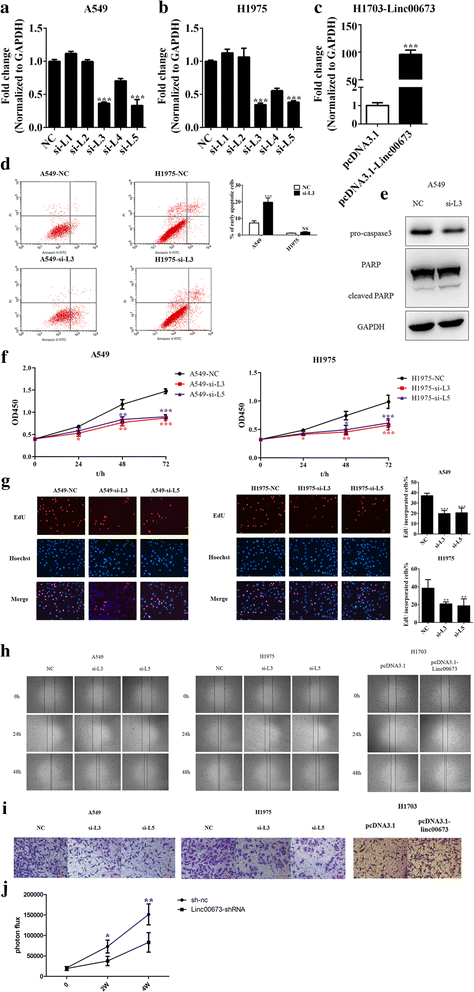
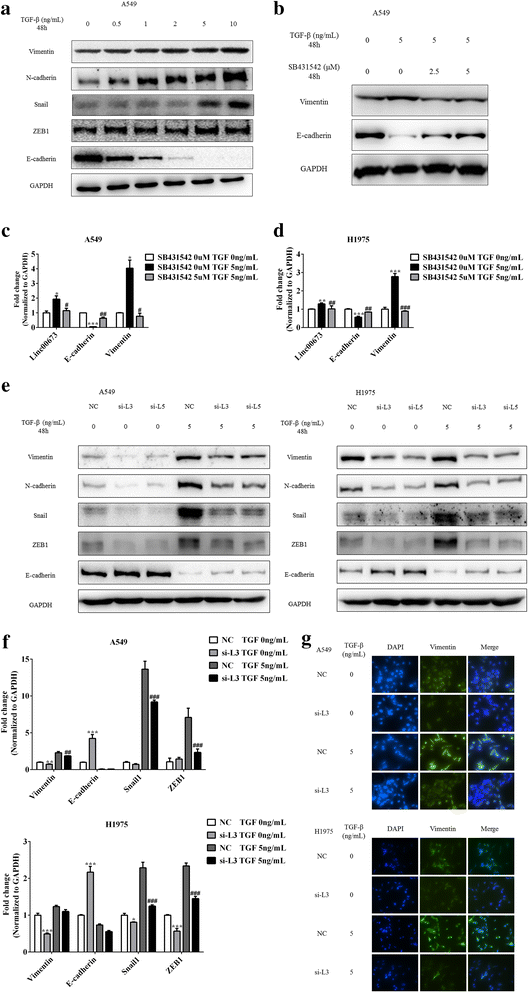
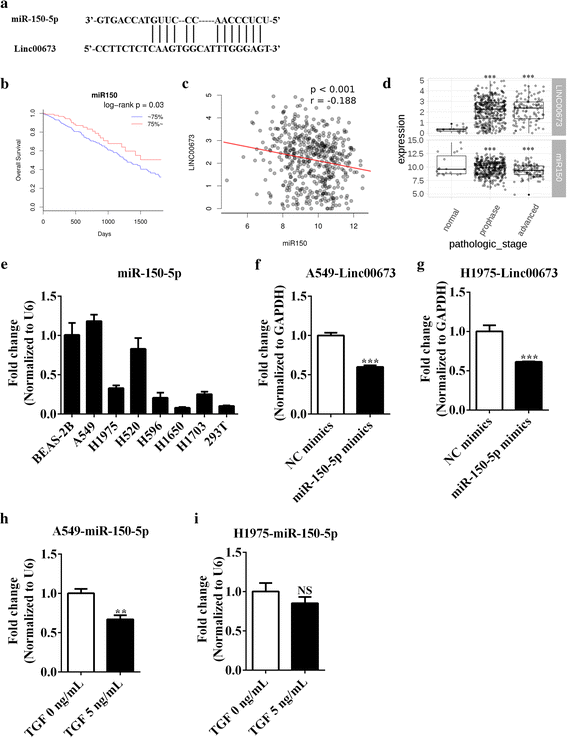
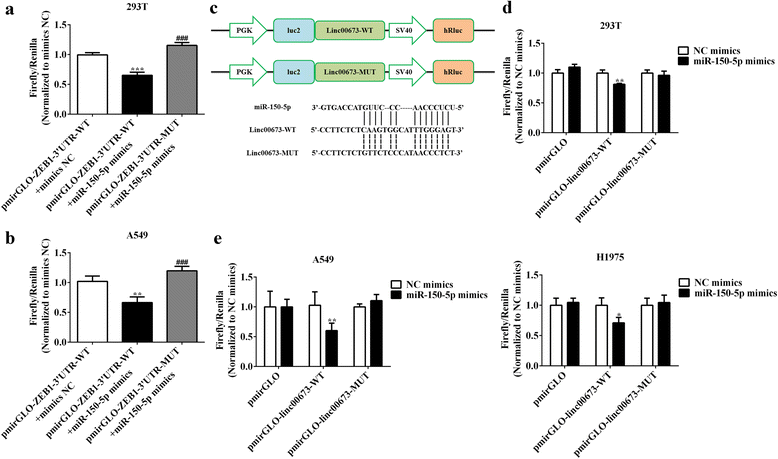

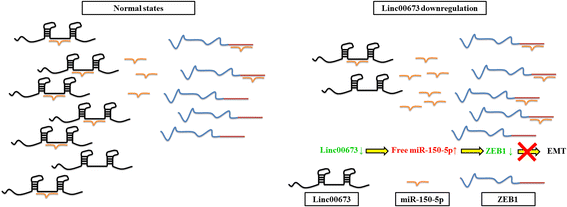
Similar articles
-
UBE2C, Directly Targeted by miR-548e-5p, Increases the Cellular Growth and Invasive Abilities of Cancer Cells Interacting with the EMT Marker Protein Zinc Finger E-box Binding Homeobox 1/2 in NSCLC.Theranostics. 2019 Mar 17;9(7):2036-2055. doi: 10.7150/thno.32738. eCollection 2019. Theranostics. 2019. Retraction in: Theranostics. 2020 Jul 25;10(21):9619. doi: 10.7150/thno.50254. PMID: 31037155 Free PMC article. Retracted.
-
Long non-coding RNA PRNCR1 modulates non-small cell lung cancer cell proliferation, apoptosis, migration, invasion, and EMT through PRNCR1/miR-126-5p/MTDH axis.Biosci Rep. 2020 Jul 31;40(7):BSR20193153. doi: 10.1042/BSR20193153. Biosci Rep. 2020. PMID: 31912882 Free PMC article.
-
LncRNA ADPGK-AS1 promotes pancreatic cancer progression through activating ZEB1-mediated epithelial-mesenchymal transition.Cancer Biol Ther. 2018 Jul 3;19(7):573-583. doi: 10.1080/15384047.2018.1423912. Epub 2018 Apr 19. Cancer Biol Ther. 2018. PMID: 29667486 Free PMC article.
-
Roles of miR-200 family members in lung cancer: more than tumor suppressors.Future Oncol. 2018 Nov;14(27):2875-2886. doi: 10.2217/fon-2018-0155. Epub 2018 Sep 13. Future Oncol. 2018. PMID: 30208739 Review.
-
A review on the role of ZEB1-AS1 in human disorders.Pathol Res Pract. 2023 May;245:154486. doi: 10.1016/j.prp.2023.154486. Epub 2023 Apr 26. Pathol Res Pract. 2023. PMID: 37120907 Review.
Cited by
-
Heat shock protein B8 promotes proliferation and migration in lung adenocarcinoma A549 cells by maintaining mitochondrial function.Mol Cell Biochem. 2021 Jan;476(1):187-197. doi: 10.1007/s11010-020-03896-3. Epub 2020 Sep 14. Mol Cell Biochem. 2021. PMID: 32926297
-
Current understanding of functional peptides encoded by lncRNA in cancer.Cancer Cell Int. 2024 Jul 19;24(1):252. doi: 10.1186/s12935-024-03446-7. Cancer Cell Int. 2024. PMID: 39030557 Free PMC article. Review.
-
SP1-induced lncRNA-ZFAS1 contributes to colorectal cancer progression via the miR-150-5p/VEGFA axis.Cell Death Dis. 2018 Sep 24;9(10):982. doi: 10.1038/s41419-018-0962-6. Cell Death Dis. 2018. PMID: 30250022 Free PMC article.
-
Long non‑coding RNA Unigene56159 promotes glioblastoma multiforme cell proliferation and invasion through negatively regulating microRNA‑194‑5p.Mol Med Rep. 2020 Feb;21(2):768-776. doi: 10.3892/mmr.2019.10852. Epub 2019 Nov 26. Mol Med Rep. 2020. PMID: 31789416 Free PMC article.
-
MARVELD3 inhibits the epithelial-mesenchymal transition and cell migration by suppressing the Wnt/β-catenin signaling pathway in non-small cell lung cancer cells.Thorac Cancer. 2023 Apr;14(12):1045-1058. doi: 10.1111/1759-7714.14844. Epub 2023 Mar 15. Thorac Cancer. 2023. PMID: 36924014 Free PMC article.
References
-
- Birney E, Stamatoyannopoulos JA, Dutta A, Guigo R, Gingeras TR, Margulies EH, Weng Z, Snyder M, Dermitzakis ET, Thurman RE, et al. Identification and analysis of functional elements in 1% of the human genome by the ENCODE pilot project. Nature. 2007;447:799–816. doi: 10.1038/nature05874. - DOI - PMC - PubMed
Publication types
MeSH terms
Substances
LinkOut - more resources
Full Text Sources
Other Literature Sources
Medical

